The order of Cetacea: whales, dolphins and porpoises
The differentiation between the words whales, dolphins and porpoises are not really appropriate as they have no scientific meaning. In the past all big cetaceans were called whales and all small ones porpoises. Some dolphins (for example killer whales) might be bigger than the smallest whales, and because of this they have the word “whale” in their name. To squash the confusion for this particular case, scientists refer to killer whales as orcas.
Today we distinguish two suborders:
- baleen whales or mysticetes and
- toothed whales or odontocetes.
Systematics of the order of cetacea
Sourced from the International Whaling Commission.
Suborder Odontoceti (toothed whales or odontocetes)
Family Scientific name Common name
| Family Physeteridae | Physeter macrocephalus | sperm whale |
| Family Kogiidae | Kogia breviceps | pygmy sperm whale |
| Kogia sima | dwarf sperm whale | |
| Family Platanistidae | Platanista gangetica gangetica | South Asian river dolphin |
| Family Pontoporiidae | Pontoporia blainvillei | franciscana |
| Family Lipotidae | Lipotes vexillifer | baiji |
| Family Iniidae | Inia geoffrensis | boto |
| Family Monodontidae | Delphinapterus leucas | white whale |
| Monodon monoceros | narwhal |
| Family Phocoenidae | Phocoena phocoena | harbour porpoise |
| Phocoena spinipinnis | Burmeister’s porpoise | |
| Phocoena sinus | vaquita | |
| Phocoena dioptrica | spectacled porpoise | |
| Neophocaena phocaenoides | finless porpoise | |
| Phocoenoides dalli | Dall’s porpoise | |
| Family Delphinidae | Steno bredanensis | rough-toothed dolphin |
| Sousa chinensis | Indo-Pacific hump-backed dolphin | |
| Sousa teuszii | Atlantic humpback dolphin | |
| Sotalia fluviatilis | tucuxi | |
| Sotalia guianensis | Guiana dolphin | |
| Lagenorhynchus albirostris | white-beaked dolphin | |
| Lagenorhynchus acutus | Atlantic white-sided dolphin | |
| Lagenorhynchus obscurus | dusky dolphin | |
| Lagenorhynchus obliquidens | Pacific white-sided dolphin | |
| Lagenorhynchus cruciger | hourglass dolphin | |
| Lagenorhynchus australis | Peale’s dolphin | |
| Grampus griseus | Risso’s dolphin | |
| Tursiops truncatus | Common bottlenose dolphin | |
| Tursiops aduncus | Indo-Pacific bottlenose dolphin | |
| Stenella frontalis | Atlantic spotted dolphin | |
| Stenella attenuata | pantropical spotted dolphin | |
| Stenella longirostris | spinner dolphin | |
| Stenella clymene | clymene dolphin | |
| Stenella coeruleoalba | striped dolphin | |
| Delphinus delphis | common dolphin | |
| Delphinus capensis | long-beaked common dolphin | |
| Lagenodelphis hosei | Fraser’s dolphin | |
| Lissodelphis borealis | northern right whale dolphin | |
| Lissodelphis peronii | southern right whale dolphin | |
| Cephalorhynchus commersonii | Commerson’s dolphin | |
| Cephalorhynchus eutropia | Chilean dolphin | |
| Cephalorhynchus heavisidii | Heaviside’s dolphin | |
| Cephalorhynchus hectori | Hector’s dolphin | |
| Peponocephala electra | melon-headed whale | |
| Feresa attenuata | pygmy killer whale | |
| Pseudorca crassidens | false killer whale | |
| Orcinus orca | killer whale | |
| Globicephala melas | long-finned pilot whale | |
| Globicephala macrorhynchus | short-finned pilot whale | |
| Orcaella brevirostris | Irrawaddy dolphin | |
| Orcaella heinsohni | Australian snubfin dolphin |
| Family Ziphiidae | Tasmacetus shepherdi | Shepherd’s beaked whale |
| Berardius bairdii | Baird’s beaked whale | |
| Berardius arnuxii | Arnoux’s beaked whale | |
| Indopacetus pacificus | Longman’s beaked whale | |
| Mesoplodon bidens | Sowerby’s beaked whale | |
| Mesoplodon densirostris | Blainville’s beaked whale | |
| Mesoplodon europaeus | Gervais’ beaked whale | |
| Mesoplodon layardii | strap-toothed whale | |
| Mesoplodon hectori | Hector’s beaked whale | |
| Mesoplodon grayi | Gray’s beaked whale | |
| Mesoplodon stejnegeri | Stejneger’s beaked whale | |
| Mesoplodon bowdoini | Andrews’ beaked whale | |
| Mesoplodon mirus | True’s beaked whale | |
| Mesoplodon ginkgodens | ginkgo-toothed beaked whale | |
| Mesoplodon carlhubbsi | Hubbs’ beaked whale | |
| Mesoplodon perrini | Perrin’s beaked whale | |
| Mesoplodon peruvianus | pygmy beaked whale | |
| Mesoplodon traversii | spade-toothed whale | |
| Ziphius cavirostris | Cuvier’s beaked whale | |
| Hyperoodon ampullatus | northern bottlenose whale | |
| Hyperoodon planifrons | southern bottlenose whale |
DESCRIPTION OF THE CETACEANS THAT ONE CAN SEE IN THE NORTHERN ADRIATIC
Bottlenose Dolphin (Tursiops truncatus)
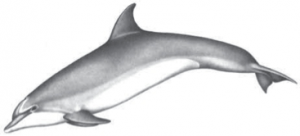 The bottlenose dolphin is a robust, chunky dolphin with a well-defined (usually short and stubby) beak, sharply demarcated from the forehead by a distinct crease. It varies in colouration from dark grey, through light grey to brown, although individuals may range in colour from all black, white (albino) to a cinnamon colour. An indistinct cape runs from the top of the melon to the dorsal fin, narrowing to a thin line behind the fin. The sides of the body are lighter than the cape and graduate laterally to a pale ventral surface from light grey to pink in colour. Individuals are commonly scarred from interactions with conspecifics, males usually being more scarred than females. The flippers are of moderate length, and pointed at the tip. The dorsal fin is falcate and located mid-back and the tail flukes have an obvious, deep median notch.
The bottlenose dolphin is a robust, chunky dolphin with a well-defined (usually short and stubby) beak, sharply demarcated from the forehead by a distinct crease. It varies in colouration from dark grey, through light grey to brown, although individuals may range in colour from all black, white (albino) to a cinnamon colour. An indistinct cape runs from the top of the melon to the dorsal fin, narrowing to a thin line behind the fin. The sides of the body are lighter than the cape and graduate laterally to a pale ventral surface from light grey to pink in colour. Individuals are commonly scarred from interactions with conspecifics, males usually being more scarred than females. The flippers are of moderate length, and pointed at the tip. The dorsal fin is falcate and located mid-back and the tail flukes have an obvious, deep median notch.
Bottlenose dolphins are cosmopolitan in distribution, found throughout the world’s oceans and seas; from temperate and tropical waters of the Atlantic, Pacific and Indian Oceans, as well as the Mediterranean, Black and Red Seas. In the Pacific they range from northern Japan and southern California to Australia and Chile. In the Atlantic they may be found from Nova Scotia and Norway to Patagonia and South Africa. They are common in the Indian Ocean from Australia to South Africa. These are the last remaining and constantly present marine mammals off Istria and Slovenia, Trieste gulf and N Adriatic. Vulnerable status by the IUCN Red list of threatened species.
Common Dolphin (Delphinus delphis, D. capensis)
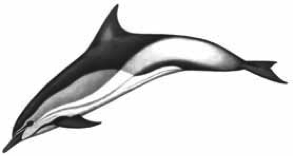 The most striking feature of the common dolphin is its characteristic hourglass pattern on the flanks; created by overlapping of the contrasting dorsal and ventral patches on the sides creating a V-shaped saddle below the dorsal fin. This overlapping results in a greyish green or bronze tan colouration of the thoracic patch on each side of the animal. The body is fine and streamlined, with a long narrow rostrum and sharp angle between the beak and forehead. The dorsal fin is tall and falcate, the fins taper to a pointed tip, and the tail flukes are concave with a distinctive median notch on the rear margin.
The most striking feature of the common dolphin is its characteristic hourglass pattern on the flanks; created by overlapping of the contrasting dorsal and ventral patches on the sides creating a V-shaped saddle below the dorsal fin. This overlapping results in a greyish green or bronze tan colouration of the thoracic patch on each side of the animal. The body is fine and streamlined, with a long narrow rostrum and sharp angle between the beak and forehead. The dorsal fin is tall and falcate, the fins taper to a pointed tip, and the tail flukes are concave with a distinctive median notch on the rear margin.
The long, well-defined beak is generally black, but often tipped with white. The dorsal fin ranges in colour from all black to mostly white with a dark border; there is often a greyish area in the middle of an otherwise dark fin. The flippers and flukes are dark grey or black, but in the eastern North Atlantic, the flippers are commonly pale – light grey to white. There is sexual dimorphism in the colouration of the areas around the genitals: males have a distinctive black blaze above the genital opening, and females have a narrower band of black with grey counter-shading.
Common dolphins are often active at the surface; jumping and splashing can be often seen and heard at great distances. They frequently breach (and may even somersault), and slap the water surface with their chins and flippers. Several members of a group will often surface together. They are fast swimmers and commonly bow-ride with boats and large whales such as fin whales, gray whales, humpbacks and blue whales.
Well-defined migrations are not known, and common dolphins are present year round in some parts of their range. In some locations, seasonal shifts in distribution are observed, for example, off Southern California where peaks of abundance are observed in June, September to October, and January. Seasonal shifts also occur off the British Isles, and it is thought that the movements may be correlated with shifting prey distribution and abundance. In the Atlantic, abundance in European continental shelf waters was estimated at 63,400. In the western Mediterranean, abundance has been estimated at 19,400between years 2000-2004. Dramatic negative trends were recorded in portions of the central Mediterranean, particularly in the northern Adriatic Sea where it is extinct. As well as in the eastern Ionian Sea. Recent genetic studies indicate that population structure within the Mediterranean reflects differences in distribution pattern and habitat use in the eastern (coastal) and western (pelagic) portions of the basin. In the Adriatic Sea seen from time to time as a single individual, which is not an usual way for this species. Mainly within in the Cres-Lošinj and Krk archipelago for the N Adriatic.
Threats: Incidental capture of common dolphins in European Atlantic fisheries; prey depletion caused by overfishing was a main cause for the decline in the eastern Ionian Sea. Global status otherwise as “least concern”.
Striped Dolphin (Stenella coeruleoalba)
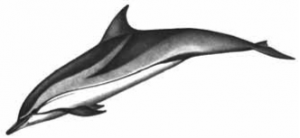 The striped dolphin has a slender body with a long dark beak. Its narrow forehead and melon are smoothly sloping and there is a distinct crease separating the forehead from the beak. It is boldly patterned in bluish grey and white, although under certain light conditions it may appear brown and white. A lateral stripe and spinal blaze are characteristic, and distinguish the striped dolphin from other white-bellied oceanic dolphins, but these markings vary significantly between individuals and probably geographically. There are 1 or 2 dark bands between the flipper and the eye, and a dark streak behind the eye (which often has a black patch around it). The sides are pale grey, as are the tail flukes. The dorsal fin is falcate and the flippers are small and slender with pointed tips.
The striped dolphin has a slender body with a long dark beak. Its narrow forehead and melon are smoothly sloping and there is a distinct crease separating the forehead from the beak. It is boldly patterned in bluish grey and white, although under certain light conditions it may appear brown and white. A lateral stripe and spinal blaze are characteristic, and distinguish the striped dolphin from other white-bellied oceanic dolphins, but these markings vary significantly between individuals and probably geographically. There are 1 or 2 dark bands between the flipper and the eye, and a dark streak behind the eye (which often has a black patch around it). The sides are pale grey, as are the tail flukes. The dorsal fin is falcate and the flippers are small and slender with pointed tips.
Striped dolphins are fast swimmers (travelling up to 15 km hour); when travelling at speed up to a third of the members of a school will be above the surface at any one time. They are highly active, breaching to heights of 7 m above the surface, and are capable of amazing acrobatics including somersaults, tail spins and backward flips.
When swimming, 2 main patterns of surfacing can be observed: the first involves dolphins rolling at the surface, emerging rostrum first and re-entering the water with the tail stock in a flexed position as the last bit of the body to submerge; the second involves animals re-entering the water with the tail extended, the fluke disappearing last – and tends to occur at higher swimming velocities. Leaping is frequently observed in this species whilst swimming at speed; the dolphins often breathing as they leap. Dives usually last from 5 to 10 minutes, and striped dolphins may dive to depths of 200 m when feeding.
It is an oceanic species. It shows a preference for highly productive, open waters beyond the continental shelf (Gulf of Lions, the waters between the Balearic Islands and the Iberian Peninsula, and the Alborán Sea. In the Ligurian Sea; in the Adriatic as extinct, only seen in small groups here and there, sometimes congregating).
Global status otherwise as “least concern”, but status for Mediterranean subpopulation: vulnerable.
Threats : subject to a number of threats that, cumulatively, reduced its size. An abrupt reduction in population size occurred in 1990–1992 due to a die-off involving many 1,000s of deaths with the mean school size to less than one third of prior levels. The cause: infection with morbillivirus. PCBs and other organochlorine pollutants with immunosuppressive effects were suggested to have enhanced its lethality. Incidental capture in fishing gear – pelagic driftnets, has been high in at least 20 years, causing thousands of deaths per year reduction in population size of >30% occurred over the last three generations (ca. 60 years).
Risso’s Dolphin (Grampus griseus)
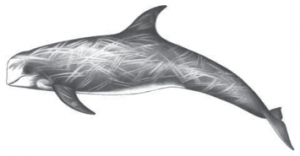 The Risso’s dolphin is a large dolphin with a robust, stocky body that becomes more slender behind the dorsal fin. Its head is bulbous, with no beak, a particularly large melon, and a mouth that slants upwards towards the eyes. A peculiar, deep V-shaped crease extends from the blowhole to the tip of the rostrum.
The Risso’s dolphin is a large dolphin with a robust, stocky body that becomes more slender behind the dorsal fin. Its head is bulbous, with no beak, a particularly large melon, and a mouth that slants upwards towards the eyes. A peculiar, deep V-shaped crease extends from the blowhole to the tip of the rostrum.
At birth, the Risso is a uniform light grey colour, but this darkens to a chocolate brown / black as the animal ages. Large animals are typically silver-grey and the body is covered with scratches and scars inflicted from conspecifics or the sharp beaks of squid during feeding. Old, mature individuals may be almost entirely white in colour. The pectoral flippers are long, narrow and curved. The dorsal fin is tall and falcate, and set at the mid-point of the body. The tail flukes are dark and broad, with a distinct median notch, pointed tips, and an overall concave outline.
Risso’s dolphins are often seen travelling and surfacing slowly, although they may be highly active often breaching clear of the water and slapping their heads, tails or sides on the surface. They sometimes surface with only their tail or head showing above the water. When travelling (at a speed of about 5 knots) they generally show the top of the head and dorsal fin as they blow. When diving, they may raise their tail flukes out of the water and descend vertically. Risso’s may remain motionless on the surface of the water for several seconds after surfacing. They also spy hop, revealing the whole head and body down to the flipper for 3 seconds or more, as if surveying their surroundings.
The species should be easily distinguishable from other species. However, calves may resemble bottlenose dolphins while older juveniles may resemble young pilot whales. Their tall dorsal fins may also be confused with bottlenose dolphins, false killer whales and killer whales, in poor conditions.
Long-finned Pilot Whale (Globicephala melas)
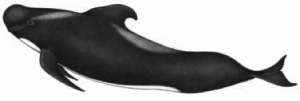 The long-finned pilot whale is a medium-sized whale with an elongated body, bulbous forehead and a short, almost imperceptible, beak. In mature males, the rounded forehead overhangs the snout. The mouth-line is curved upwards and the crescentric blowhole is set slightly to the left of centre on the top of the head. The dorsal fin is prominent and falcate, with a low profile and long base, and is located relatively far forward on the back (about a third of the way back from the head). In adult males, the dorsal fin may have a thicker leading edge and rounder form than in females. Flippers are long and slender, with pointed tips and an angled leading edge forming an ‘elbow’. The tail stock has a thick keel. Tail flukes are pointed at the tips with a concave trailing edge and a deep median notch.
The long-finned pilot whale is a medium-sized whale with an elongated body, bulbous forehead and a short, almost imperceptible, beak. In mature males, the rounded forehead overhangs the snout. The mouth-line is curved upwards and the crescentric blowhole is set slightly to the left of centre on the top of the head. The dorsal fin is prominent and falcate, with a low profile and long base, and is located relatively far forward on the back (about a third of the way back from the head). In adult males, the dorsal fin may have a thicker leading edge and rounder form than in females. Flippers are long and slender, with pointed tips and an angled leading edge forming an ‘elbow’. The tail stock has a thick keel. Tail flukes are pointed at the tips with a concave trailing edge and a deep median notch.
The adults are almost completely black in colour, whereas new-born and immature animals are lighter in colour and younger whales are often slightly spotted with grey. Most adults have scars, ranging from squid sucker marks to tooth scars caused by interactions with conspecifics. Adults generally have light markings on the throat and belly and sometimes behind the dorsal fin and eye; typically a long anchor-shaped ventral patch, dorsal saddle and eye blaze are noted.
Surface resting behaviour in bouts of 15 minutes are common in this species, mainly in the morning following night time foraging activities. Pilot whales are often calm and fairly inactive at the surface. Entire herds may be seen gathered in log-like rafts or lines with little apparent motion and just the dorsal fin and blowhole exposed. They sometimes hang vertically with the head and forepart of the flippers exposed, spy-hopping. Lob-tailing is also common. They rarely breach, although younger animals are more active than adults.
Fin Whale (Balaenoptera physalus)
 The fin whale is very streamlined in appearance but slightly fuller in shape than the blue whale, rounded in the front, but compressed laterally in the tail region with a distinct ridge along the back behind the dorsal fin (hence the name “razorback”). The head is about 1/4 of its body length, or slightly larger in adults, and is markedly triangular in dorsal view and flat with a median crest. The jaw is large and strongly convex laterally, so that when the mouth is closed the lower jaw protrudes slightly beyond the tip of the snout. The dorsal fin is set two thirds of the way along the back, and is up to 60 cm tall, falcate, and often slopes backwards. Its tip may be pointed or rounded. The flippers are slender and relatively short with a pointed tip. The tail flukes are broad (1/5 the length of the body) with a distinct median notch and slightly concave trailing edge.
The fin whale is very streamlined in appearance but slightly fuller in shape than the blue whale, rounded in the front, but compressed laterally in the tail region with a distinct ridge along the back behind the dorsal fin (hence the name “razorback”). The head is about 1/4 of its body length, or slightly larger in adults, and is markedly triangular in dorsal view and flat with a median crest. The jaw is large and strongly convex laterally, so that when the mouth is closed the lower jaw protrudes slightly beyond the tip of the snout. The dorsal fin is set two thirds of the way along the back, and is up to 60 cm tall, falcate, and often slopes backwards. Its tip may be pointed or rounded. The flippers are slender and relatively short with a pointed tip. The tail flukes are broad (1/5 the length of the body) with a distinct median notch and slightly concave trailing edge.
Colouration is dark grey to brownish black dorsally, grading to pale or white ventrally. The undersides of the flippers and flukes are also white. The head is asymmetrical in colour; mostly dark, but the right lower jaw is white. The body is free of mottling or extensive scarring. Some whales have a pale grey chevron on each side behind the head and there may be a dark stripe running up and back from the eye and a light stripe arching down to where the flipper joins the body.
There are 50 to 100 ventral pleats, from the chin to the umbilicus or slightly beyond the mid line. Each side of the jaw has between 260-480 baleen plates which are also dark on the left and pale on the right and upto 72 cm long and 30 cm wide. The plates have yellow to white fringing fibres, are soft compared to blue whale baleen, and vary from yellowish-white to greyish-white in colour.
Fin whales are fast moving and may swim at speeds of up to 41 km per hour when alarmed, 30 km per hour in short bursts when migrating or cruising, and 2 – 6.5 km per hour when feeding. During migration, it has been calculated that they swim about 90 miles a day.
Sperm Whale (Physeter macrocephalus)
The sperm whale has a huge, square head which is 1/3 to 1/4 of the total body length (enclosing the large brain, spermaceti organ and associated structures; the spermaceti organ contains oil-like wax for which the sperm whale was highly valued and relentlessly hunted). Colouration is dark grey to brown in colour, although calves are lighter in colour than adults. The belly and front of the head may be whitish to grey and there may be white patches in the genital region and sometimes elsewhere on the body. A single blowhole is located on a slightly raised lump on the front left side of the rostrum. The lower jaw is underslung and extremely long and narrow, and contains 17 to 29 pairs of mandibular teeth measuring up to 25 cm long in very old males. When the mouth is closed the teeth fit into circular depressions in the palate of the upper jaw in which vestigial teeth are found at the apex of these depressions. The lips and lower jaw are white.
The body, behind the head, has an irregular wrinkled appearance, and the dorsal fin is low, thick and rounded or pointed. There is a dorsal ridge, running back from the dorsal fin which may be crenulated, and the tail stock has a thick ventral keel behind the anus. Flippers are broad and rounded but small relative to body size, and often held close to the body. The tail flukes are broad and have a variably- shaped trailing edge with a deep central notch.
Sperm whales swim fairly slowly at the surface, rarely exceeding 7.5 km per hour unless disturbed, when they can swim at bursts of 30 km per hour. They may remain at the surface for extended periods of time, without moving between blows. They are a deep diving species and are able to perform long and deep dives, often lasting 60 to 90 minutes. Most dives apparently occur to depths of 400-600 m, but sperm whales may be capable of diving to depths of over 3,000 m. At the beginning of a dive, the whales usually fluke-up (lift their tail flukes clear of the water). They may decend at over 80 m per minute, and usually remain submerged for 40 to 50 minutes followed by about 10 minutes at the surface. When resting and socialising, the ventilation pattern changes, becoming less obvious and regular than the strong, 4 to 6 blows per minute which are common before a deep dive. Observations of sperm whales have indicated that large bulls are able to dive more deeply and for longer than females and small males.
These whales often perform aerial behaviours including breaching and lobtailing. These behaviours often occur in a social context and when groups were splitting or joining. Single whales also breach and lobtail.
Cuvier’s Beaked Whale (Ziphius cavirostris)
 They have a relatively robust, cigar-shaped body with a small conical head. There is often a visible indentation behind the blowhole. There is an indistinct beak that become less distinct with age. Adult males have two small, conical teeth in the tip of the lower jaw that may be visible, and are sometimes covered by a clump of stalked barnacles. The body is a mottled golden tan to reddish brown often with scarring. The head and neck are often white, especially in adults, with a dark patch around the eye. Much of the back may be whitish in older males. The flippers are short and tapered, and the dorsal fin is falcate, small to moderately-sized, and about two-thirds of the way back. The flukes are concave on the trailing edge and usually lack a notch in the center.
They have a relatively robust, cigar-shaped body with a small conical head. There is often a visible indentation behind the blowhole. There is an indistinct beak that become less distinct with age. Adult males have two small, conical teeth in the tip of the lower jaw that may be visible, and are sometimes covered by a clump of stalked barnacles. The body is a mottled golden tan to reddish brown often with scarring. The head and neck are often white, especially in adults, with a dark patch around the eye. Much of the back may be whitish in older males. The flippers are short and tapered, and the dorsal fin is falcate, small to moderately-sized, and about two-thirds of the way back. The flukes are concave on the trailing edge and usually lack a notch in the center.
Cuvier’s beaked whales may be confused with minke whales, bottlenose whales, and other beaked whales. They can be differentiated from minke whales by differences in head shape, the white head, lack of a white flipper band, absence of extensive ventral grooves, and occurrence of fluking. The can be differentiated from bottlenose whales by smaller size, no bulbous forehead, and no distinct beak. They can be differentiated from other beaked whales by larger size and lack of an elongate beak.
Humpback Whale (Megaptera novaeangliae) **not living in the Adriatic Sea
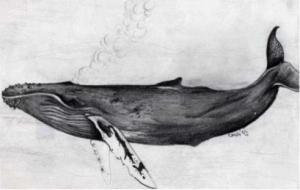 A visit of this species was in the Slovenian Sea in February 2009. It was about subadult individuum that got lost, probably already at the Gibraltar strait, whilce having a seasonal migration towards north.
A visit of this species was in the Slovenian Sea in February 2009. It was about subadult individuum that got lost, probably already at the Gibraltar strait, whilce having a seasonal migration towards north.
Humpback whales are distinguished from other whales in the balaenopterid family by their extraordinarily long flippers, short robust body, fewer throat grooves and the utilisation of very long, complex, repetitive vocalisations during courtship (click on image right to hear the humpback’s song). The head is large and rounder than in other baleen whales. The top of the snout is covered in rows of distinctive, sub-cutaneous knobs; there are several knobs either side of the blowhole. The humpback’s flippers are particularly distinctive, long and narrow and measuring up to 30 % of the total body length. They may be black to white in colour dorsally, but the ventral surface is all white with a few grey speckles. The anterior margin of each flipper is scalloped and each knob usually has barnacles on it, as sometimes does the dorsal fin; which is low and widely variable shape from falcate to a slight nub.
Humpbacks range in colour from completely black to black with white markings on the throat, abdomen and sides. In some individuals the belly may be completely white and there may be white markings behind the eyes and on the back and head. The baleen plates are black to brown and grey, and may have some lighter fibres and black or greenish black bristles. The outside of the mouth usually matches the baleen in colour. There may be 270 to 400 coarse, short plates of baleen on each side of the jaw, each plate measuring upto 1 m in length and 30 cm in width.
The tail flukes are characteristic of the species, both in shape and colour. The trailing edge is usually serrated and often deeply notched in the centre. The dorsal surface is dark, while the ventral surface is black or black and white. The fluke colouration is unique for each whale and is used in photo-identification of individual animals.
Swimming speed may reach up to 27 km per hour, but usually ranges from 4 to 14 km with an average speed of 8 km per hour in migrating animals. Cows accompanied by calves tend to swim slowly, and lone animals swim faster than those in groups.
When diving, humpbacks generally remain submerged for less than 6 or 7 minutes, although longer dives of 15 to 30 minutes have been recorded. When making short dives, blows tend to be irregular and the tail flukes are not lifted when submerging. When starting a longer dive, the whales usually lift their flukes, surface between dives for about 4 minutes blowing regularly. Groups of 2 or 3 whales may dive and surface together. Calves spend longer at the surface whilst lone humpbacks and feeding whales spend the least amount of time at the surface. These whales do not generally dive deeper that 120 to 150 m.
The humpback whale is perhaps the most acrobatic of all the great whales, exhibiting a variety of surface and underwater behaviours. Humpbacks often breach, spyhop, lobtail and tail slap at the surface and their bushy blow from the double blowhole is distinctive even from some distance.
Taxonomy of Whales. International Whaling Commission. Retrieved May 23, 2016, from https://iwc.int/cetacea#odontoceti.
